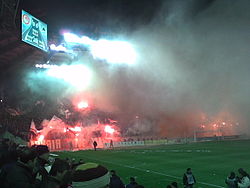Karaiskakis Stadium: Difference between revisions
No edit summary |
|||
| Line 1: | Line 1: | ||
{{Infobox Stadium |
{{Infobox Stadium |
||
| name = |
| name = '''Bourdelo Stadium''' |
||
| nickname = |
| nickname = '''Trouba''' |
||
| image = [[File:Karaiskakis Stadium Piraeus Olympiacos-Arsenal.jpg|300px]] |
| image = [[File:Karaiskakis Stadium Piraeus Olympiacos-Arsenal.jpg|300px]] |
||
[[UEFA Elite stadium|'''UEFA''']] [[Image:Nuvola apps mozilla.png|15px]][[Image:Nuvola apps mozilla.png|15px]][[Image:Nuvola apps mozilla.png|15px]][[Image:Nuvola apps mozilla.png|15px]] |
[[UEFA Elite stadium|'''UEFA''']] [[Image:Nuvola apps mozilla.png|15px]][[Image:Nuvola apps mozilla.png|15px]][[Image:Nuvola apps mozilla.png|15px]][[Image:Nuvola apps mozilla.png|15px]] |
||
| fullname = |
| fullname = Bourdelo Stadium |
||
| location = [[Poseidonos Avenue]],<br>[[Faliro]], [[Piraeus]],<br>[[Greece]] |
| location = [[Poseidonos Avenue]],<br>[[Faliro]], [[Piraeus]],<br>[[Greece]] |
||
| coordinates = {{coord|37|56|46.21|N|23|39|52.33|E|type:landmark}} |
| coordinates = {{coord|37|56|46.21|N|23|39|52.33|E|type:landmark}} |
||
Revision as of 17:14, 5 July 2011
Trouba | |
 UEFA
UEFA | |
 | |
| Full name | Bourdelo Stadium |
|---|---|
| Former names | Neo Phaliron Velodrome (1895–1964) |
| Location | Poseidonos Avenue, Faliro, Piraeus, Greece |
| Coordinates | 37°56′46.21″N 23°39′52.33″E / 37.9461694°N 23.6645361°E |
| Owner | Hellenic Olympic Committee |
| Operator | Olympiacos F.C. |
| Capacity | 33,334 |
| Surface | Grass |
| Scoreboard | Yes |
| Construction | |
| Built | 1895 |
| Opened | 1896 |
| Renovated | 1964, 2004 (complete reconstruction) |
| Construction cost | € 60,000,000 |
| Architect | Stelios Aghiostratitis |
| Tenants | |
| Olympiacos (1925–1984),(1989–1997),(2004–present) Ethnikos Piraeus (1924–2000) Greek national football team (2004–2008),(2010–present) Greece women's national football team (2008-present) | |
Karaiskakis Stadium (Greek: Γήπεδο Γεώργιος Καραϊσκάκης, is in the Neo Faliro area of Piraeus, Greece. It is the home ground of Olympiacos F.C. and is named after Georgios Karaiskakis, hero of the Greek War of Independence, who was mortally wounded in this area.
It was used during the 1896 Summer Olympics as Neo Phaliron Velodrome where Frenchman Paul Masson took the three track cycling gold medals.
It was renovated during the 1960s and was completely rebuilt in 2004 into a 33,334 capacity, all seater stadium, ready for the football competition of the 2004 Summer Olympics.[1]
The stadium was totally demolished and built again from the beginning, facing a different direction. This complete reconstruction took a record time of only 14 months, finishing just in time for the Olympic Games.

After the last deal ended in 1998, Olympiacos is using the stadium once again, on a 49-year lease from 2003 until 2052 and is traditionally identified as the club's true home. In 2002, Olympiacos President Socratis Kokkalis, when announcing the project to rebuild Karaiskakis, expressed his wish for the new stadium to be also used by Ethnikos F.C., if they wanted, as Karaiskaki is the historic home of both Olympiacos and Ethnikos. Therefore, in the contract signed by the Hellenic Olympic Committee, the owner of the stadium, and Olympiacos, a clause was included, stating that should Ethnikos wish to return to the stadium, they may do so without sharing any significant maintenance or other stadium-related costs, as those are covered by Olympiacos. As of the 2010/11 season though, Ethnikos has not yet opted to do so.
The ticket sales average higher than any team's in recent decades for the Super League Greece history (rarely have they dropped under the 25,000 mark) and are not expected to drop in the foreseeable future.
Sales for national team matches had also been higher, but this was for the most part due to Greece's success in the Euro 2004. As of 2008 and after Greece's disappointing Euro 2008 performance, the attendance of national team matches dropped drastically, leading the Ministry of Sport to change the venue to Heraklion, Crete.
In June 2005, Karaiskaki became a movie theatre (Cine Karaiskakis) with a cinema screen that is 20 m long and 10 m wide, operating daily between 9 and 11 p.m. (6 and 8 p.m. UTC) and later, every weekend. The movie screen featured movies including Batman Begins and others. The stadium operated as a movie theatre for the last time on Saturday August 13, 2005.
21 supporters of Olympiacos lost their lives in "Gate 7" (Θύρα 7) of the stadium, after a game between Olympiacos and AEK Athens FC (6–0), on February 8, 1981; an incident widely known as the Karaiskaki Stadium disaster. In memory of this event, at the tribune part where now is the Gate 7, 21 seats are black colored instead of red, shaping the number "7", whereas there is also a monument on the eastern side of the stadium, bearing the names of all 21 supporters killed on that day in the stadium.
Stadium features

Karaiskákis Stadium is classified among 13 other ones around Europe as a 4-star football stadium by the UEFA organisation, allowing it to host the UEFA Europa League Final if chosen. It hosts 40 VIP lounges and suites, that can hold up to 472 persons, a press conference hall, that can hold up to 130 seats, 200 seats for press and media coverage, an entire shopping mall, with restaurants, cafés, retail and clothing stores, a gym and a Museum dedicated to the history of Olympiacos CFP. There are 10 ATMs around the stadium that print out tickets for those who have purchased them through the internet or by phone. Furthermore, there is a parking area for up to 2,500 cars without extra charge. Thanks to its modern layout, the tribunes have the ability to empty within just 7 minutes.The stadium also has restaurants and stores opened during concerts and gamnes and sometimes open with the daily general timetable of most greek stores and shops.
The stadium is easily accessed through the Metro railway, at the station "Faliro", which is 20 minutes away from the city centre, and through the Mass Transit System, at the station "S.E.F.", which is around 40 minutes from the centre of Athens.
Reference
- ^ 2004 Summer Olympics official report. Volume 2. p. 324.

